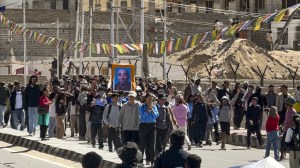How you buy a good deodar tree for Rs 5
MARCH 26: Environmentalists are up in arms against Himachal Pradesh's move to allow the felling of green forest trees for commercial purpo...

MARCH 26: Environmentalists are up in arms against Himachal Pradesh’s move to allow the felling of green forest trees for commercial purposes. Yet an equally controversial and politically sensitive issue, that of timber distribution (td) rights, have never got the attention it deserves.
This century-old system aimed at giving constructional timber at concessional rates to the right holdersvillagers living near the forests, now has become one of the most serious threats towards sustainable forest management. Multiplication of the right-holders, its misuse and major loopholes in the system has only resulted in the large-scale denudation of forests thanks to illicit fellings and timber smuggling. The forest experts, who saw some of the best managed forests fast depleting, primarily because of the td rights exceeding their carrying capacity, term “td” as “tb” (tuberculosis) of the forests.
The government, although it admits that the problem is a serious one, lacks the courage to act since it will have major political repercussions. A high level committee, which had inquired into the issue in some depth, has already submitted its recommendations to the government. But Himachal’s forest minister, Roop Singh Thakur, is hesitant. “Unless, the Congress also agrees to support the move to impose certain curbs proposed by the committee, the government will not be able to take a firm decision,” he says.
But the villagers, except those who are themselves involved in misusing timber distribution rights, favour the curbs. A panchayat pradhan, Shanti Devi, puts it like this, “If our needs for timber for construction of houses, fuel wood, and so on, are met, where is the need to enter the forests?”
Official estimates show almost 50 per cent of timber removals from the forests are made in the name of timber distribution rights. At least 1.5 lakh cubic metre of the standing value of trees the market value of which could be around Rs 55 to 58 crore goes under the guise of timber distribution at a rate varying from Re 1 to Rs 5 per tree. Since the system involves the "cut and carry method" and the marking of the trees is done by lower-rank forest officials, there is greater scope for officials conniving with unscrupulous agents to fell some of the best trees or carry on illicit fellings.
There is also enormous scope for misuse. The timber that is earmarked for personal use makes its way to the market instead. This is besides commercial removals under working plans, salvage markings and other minor and major forest extractions.
Thus the pressure on the forests seems to have grown manifold. According to Dr Virender Sharma, an environment activist and bio-diversity expert, this is in no way compensated by official forest regeneration programmes.
A close scrutiny of the whole timber distribution rights system reflects an alarming trend. It lacks uniformity and differs from district to district in terms of the rate chargeable and quantity of the timber. Not only are permanent residents of the state given these rights, other settlers too have become eligible. Divisions within families have led to the proliferation of rights holders, irrespective of the fact that forests in their vicinity may have been exhausted. There is, incidentally, no demand for reciprocity from these rights holders in terms of their responsibility to protect and conserve forest wealth.
Former principle chief conservator of forests, V.P. Mohan, who is also currently working as a consultant with some international agencies on forestry projects, recalls having started a pilot scheme in the tribal district of Lahul Spiti. Instead of allowing the right holders to enter the forests, they were given constructional timber from the depots of the state forest corporation. The scheme was a success but was never extended to other districts for political reasons.“If things are allowed to go like this, a stage will come when there will be more td rights holders than forest trees,” he cautions.
The government finally seemed to wake up to the issue and set up a committee, which had finalised its recommendations last month. Its recommendations laid emphasis on the regulation of timber distribution rights rather than the imposition of major curbs. The proposals include raising the rates of the timber given under the timber distribution category, and defining genuine rights holders and the periodicity of their allotments. Says a member of the committee,“Rates will now be in sync with market prices and the number of rights holders will also be frozen to exclude those who are not permanent residents here. There is also a proposal to issue timber distribution pass books and introduce a monitoring system to check how the timber thus allotted. Those who misuse these rights will be deprived of them.”
Himachal Pradesh, which has total geographic acres of 55,673 sq km, has 35,407 sq km recorded as forests although the actual area under tree cover is estimated at 11,780 sq km. In 1993, the figure had stood at 37,591 sq km.
So the sharp decrease in forest cover is quite evident. According to Mohan, the former principal chief conservator, a serious exercise is already on to analyse existing forest management policies and come out with specific recommendations for formulating a new forest policy for the state. Says he, “If forests are to be saved, then these issues are required to be tackled effectively, scientifically and urgently.”





- 01
- 02
- 03
- 04
- 05


























